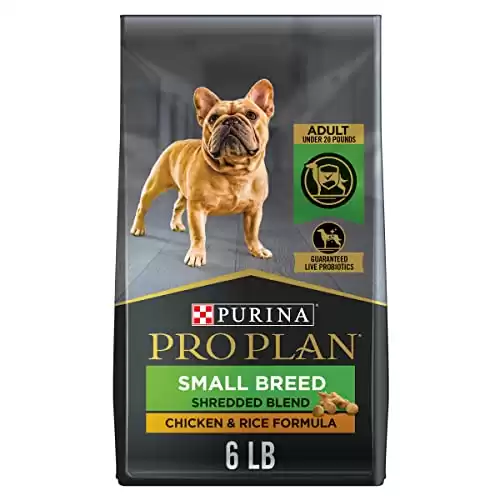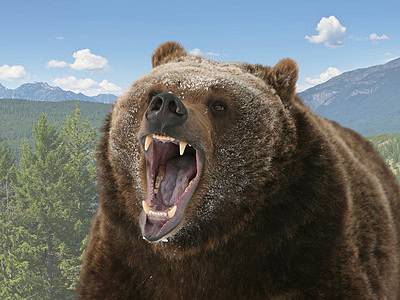Russell Terrier
Canis lupus
The Russell Terrier was bred to be a good fox hunter with a keen sense of smell
Advertisement
Russell Terrier Scientific Classification
- Kingdom
- Animalia
- Phylum
- Chordata
- Class
- Mammalia
- Order
- Carnivora
- Family
- Canidae
- Genus
- Canis
- Scientific Name
- Canis lupus
Read our Complete Guide to Classification of Animals.
Russell Terrier Conservation Status
Russell Terrier Facts
- Fun Fact
- The Russell Terrier was bred to be a good fox hunter with a keen sense of smell
- Temperament
- Curious, alert, and friendly
- Diet
- Omnivore
Russell Terrier as a Pet:
- General Health
- Energy Level
- Shedability
- Trainability
- Intelligence
- Tendency to Chew
- Size
- Family and kid friendliness
- Yappiness / Barking
- High
- Separation Anxiety
- High
- Preferred Temperature
- Average climate
- Exercise Needs
- Moderate
- Friendly With Other Dogs
- High
- Pure bred cost to own
- $500 to $1,500
- Dog group
- Terrier
- Male weight
- 9-15 lbs
- Female weight
- 9-15 lbs
This post may contain affiliate links to our partners like Chewy, Amazon, and others. Purchasing through these helps us further the A-Z Animals mission to educate about the world's species.
View all of the Russell Terrier images!
While the Russell Terrier is rarely used as a hunting dog anymore, that has not actually dulled its hunting instincts. This is a highly athletic breed with a tendency to chase things.
The Russell Terrier (also known as an English Russell Terrier in some parts of the world) is a small, alert, and lively dog that was originally bred in the middle of the 19th century as an exemplary fox hunter, but now it’s also treasured as a companion and friend. The “father” of the Russell Terrier was Reverend John “Jack” Russell, an enthusiastic dog breeder who also earned the nickname of The Sporting Parson for his passionate embrace of fox hunting. He bred his dogs to be independent-minded and excellent problem solvers so they could locate foxholes and either drive out the fox or pin it down.
See all of our expert product reviews.
The Russell Terrier is characterized by a rectangular body, floppy ears, upturned tail, and alert, expressive eyes. The dog’s straight though not hypoallergenic coat comes in three different varieties: smooth, rough, and broken. The rough coat variant is more like the typical long-haired terrier, especially around the snout and eyes. The smooth coat has very short hair all over the body. The broken coat is somewhere in between with long patches somewhere on the body. All three variations have white markings mixed with tan, black, or both.
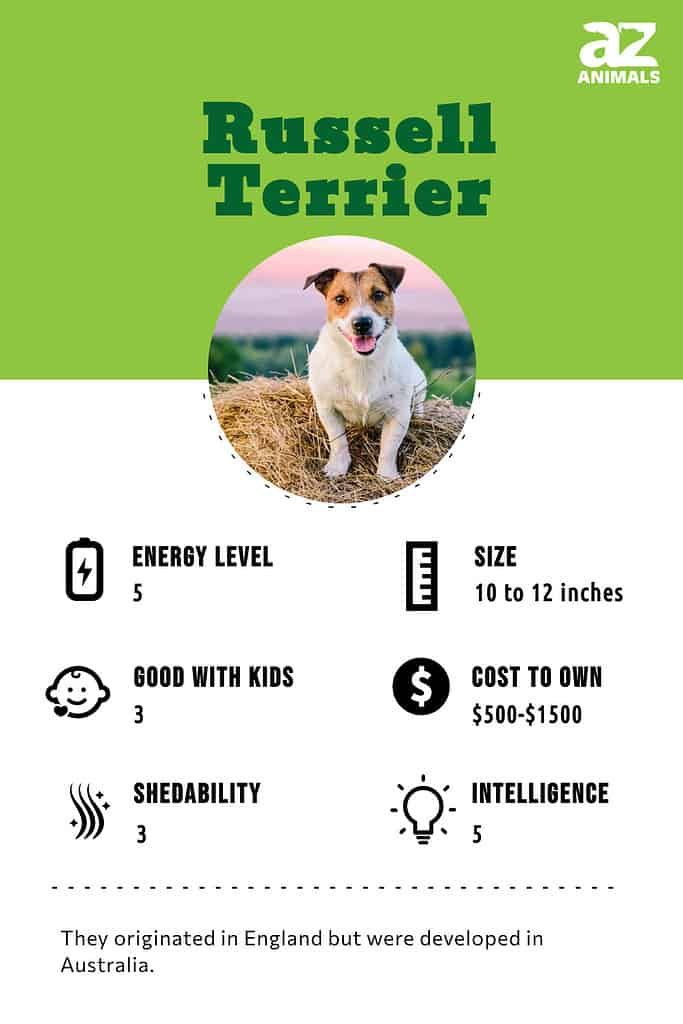
What Is The Difference Between A Russell Terrier, Jack Russell Terrier And A Parson Russell Terrier?
All three breeds of the Russell Terrier were created by Reverend Jack Russell to be fox hunting specialists. In practice, however, they are very difficult for a layperson to tell apart. The Parson Russell Terrier has a squarer body, wider chest, and a larger head. They are usually preferred for hunting purposes. The Russell Terrier and Jack Russell Terrier both have a more rectangular body and smaller heads. They are so similar, in fact, that most organizations (like the American Kennel Club) consider them the same breed and are often just referred to as the Jack Russell. When differences are recognized, the Russell Terrier tends to be the smallest of the three breeds.
History Of The Breed

A small white and tan female terrier was the basis for the breeding program that started the Russell Terrier breed.
©See page for author, Public domain, via Wikimedia Commons – Original / License
The Russell Terrier originated in England in the mid-1800s and is believed to be a descendant of the now-extinct English white terrier. They were first bred by the Revered John “Jack” Russell, a parson and hunting enthusiast who purchased what was his ideal dog at the time – a small white and tan female terrier who was the basis for the breeding program to develop a dog that had the courage and stamina to hunt and chase foxes. These dogs were recognized as an individual breed in the mid-1800s.
Health and Entertainment for your Russell Terrier
See all of our expert product reviews.
3 Pros And Cons Of Owning A Russell Terrier
| Pros! | Cons! |
|---|---|
| Fun and Lively The Russell Terrier is a very fun companion dog to have around the home. | Stubborn The Russell Terrier may resist training if it becomes bored or impatient. |
| Intelligent and Dedicated This breed really loves to devote itself to a task and keep working at it. | High Maintenance The Russell Terrier needs an active, engaged owner who can provide supervision. |
| Energetic The Russell Terrier loves to exercise and play with its owner. | Tendency to Dig This breed enjoys digging holes, but it can be dissuaded from this behavior with proper training. |
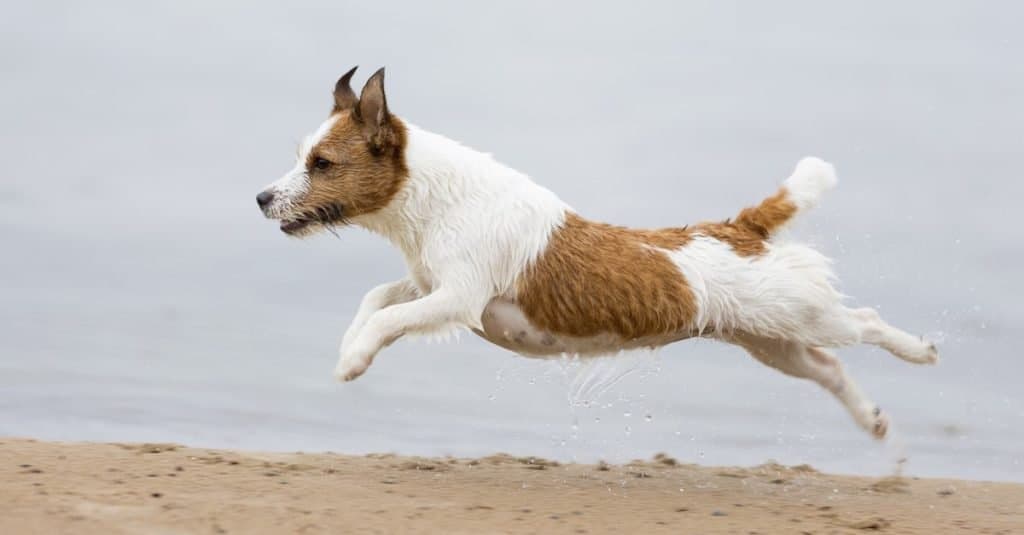
©Vivienstock/Shutterstock.com
Size And Weight
Russell Terrier is a small, compact dog with a rectangular body. There are minimal differences between males and females.
| Height (Male) | 10 to 12 inches |
| Height (Female) | 10 to 12 inches |
| Weight (Male) | 9 to 15 pounds |
| Weight (Female) | 9 to 15 pounds |
Common Health Issues
The Russell Terrier is a fairly healthy breed with a solid lifespan of between 12 and 14 years. Nevertheless, this breed is prone to several debilitating conditions, including glaucoma, deafness, cancer, Legg-Calve-Perthes Disease (deformation of the hip joint as a result of interrupted blood flow), patellar luxation (essentially, a loose knee cap), and lens luxation (a deterioration of the ligament that holds the lens in place). Good dog breeders should ideally screen for these conditions before you even bring your dog home. If it hasn’t been screened yet, then you might want to consider doing some of these evaluations and tests on the first visit to the vet. To sum up the most common health problems:
- Glaucoma
- Deafness
- Cancer
- Patellar Luxation
Temperament
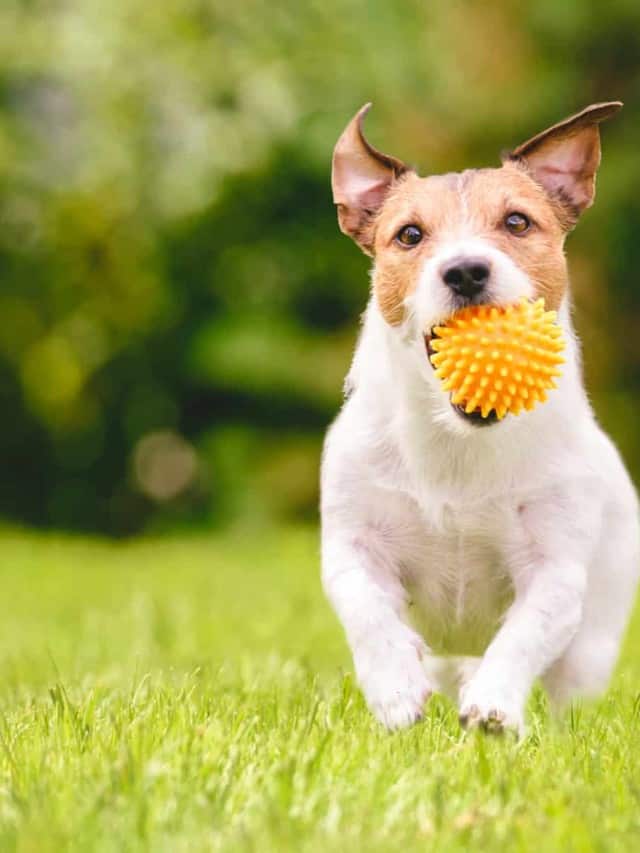
This terrier is a tireless, fearless and determined worker.
©iStock.com/alexei_tm
The Russell Terrier is a feisty, energetic, and strong-minded dog with a big personality. That does not mean it just goofs off, however. Its history as a hunting dog has also made it a tireless, fearless, and determined worker and problem solver. This dog needs structure and supervision throughout the entire day to prevent it from becoming bored and exhibiting some bad behavior. Fortunately, as long as it gets enough exercise throughout the day, it doesn’t need too much living space, so it should adapt well to an apartment.
How To Take Care Of The Russell Terrier
The Russell Terrier has many excellent qualities to offer a prospective owner, but that does not mean everyone will enjoy it. The dog’s independent personality and active behavior require an owner who really understands how to work with this breed or similar types of dogs. Nevertheless, if you’re willing to put in the time and effort, even first-time owners can enjoy this breed as a loyal friend and companion. It’s just very important to understand the breed characteristics first. By carefully planning for its diet, grooming, and exercise needs ahead of time, you should be able to avoid some problems later on down the road. You should also be prepared to care for its health-related needs with regular physical examinations at the vet.
The Best Dog Food For Russell Terriers

Do not leave food out for your Russell terrier or else it may become overweight.
©Iryna Inshyna/Shutterstock.com
A full-grown adult Russell Terrier will probably need around 1.5 cups of high-quality food per day, although this amount can vary slightly based on the dog’s age, size, and activity level. It’s recommended that you divide it up into two meals per day to ease digestion. Do not leave food out, or else it may become overweight.
Though these spunky dogs tend to be relatively healthy, every owner wants the best for their canine pal. Select a dog food containing all the essential nutrients, plus supplements that address the most likely conditions to impact your Russell Terrier.
Along these lines, A-Z Animals thinks the best dog food for Russell Terriers is Purina Pro Plan Small Breed Shredded Formula Lamb & Rice Adult Dry Dog Food.
This small breed diet has just the right balance of phosphorus, calcium, and other minerals that help your dog develop and maintain strong bones and joints and the cartilage that keeps them moving. The protein from lamb and poultry also provides natural glucosamine for added joint support to prevent bad knees. Plus, live probiotics boost digestive health to enhance the immune system.
Check Chewy or Amazon for this product.
- Shredded Blend Chicken & Rice Formula with probiotics for small dogs
- Fortified with probiotics for digestive and immune health
- Calcium, phosphorus and other minerals maintain strong bones and teeth
- Prebiotic fiber from wheat bran for digestive health
Maintenance And Grooming
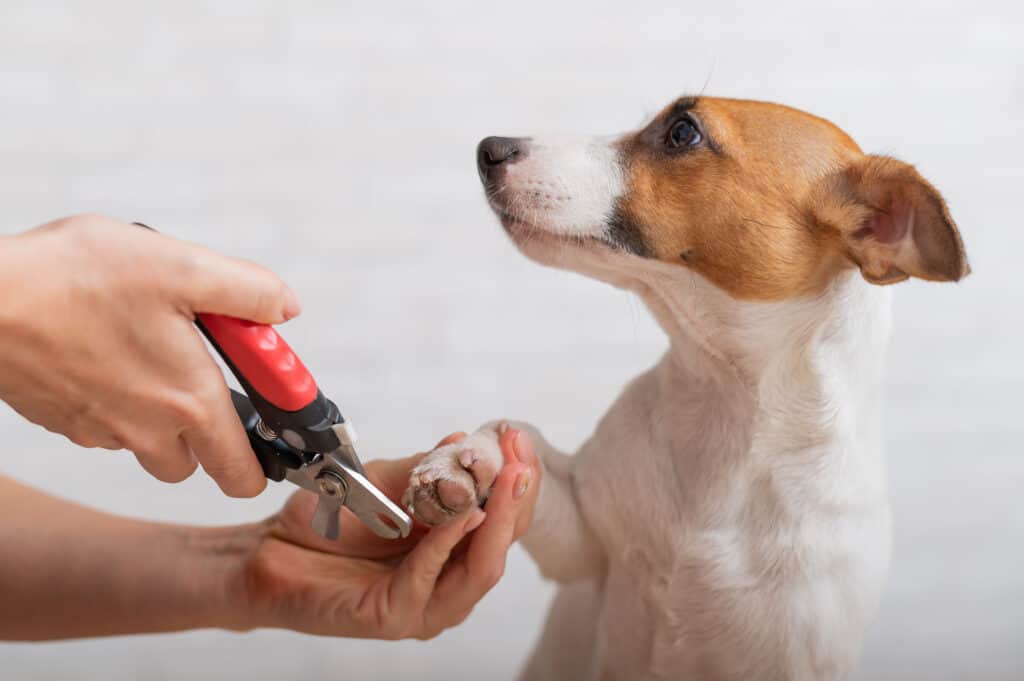
You should trim the nails about once a month and check the ears for wax or debris about once a week.
©Reshetnikov_art/Shutterstock.com
As mentioned previously, the Russell Terrier comes in three different coats: rough, broken, and smooth. All three variants require weekly grooming with a soft brush, as they tend to be moderate shedders. This is enough for the smooth coat. But if you have a broken or rough coat dog, then there is one additional requirement: it may need to be hand stripped once or twice a year. Hand stripping is a method of removing the dead fur from the top layer by hand, thus preserving the consistency of the entire coat. If the top of the fur is trimmed instead, then it might cause the softer lower layer to dominate, which some owners may not want.
In addition to its grooming needs, you should trim the nails about once a month and check the ears for wax or debris about once a week. The teeth will also need to be brushed about two or three times per week to prevent disease and bad breath. Finally, bathing should be reserved only for when the dog becomes particularly dirty.
Training
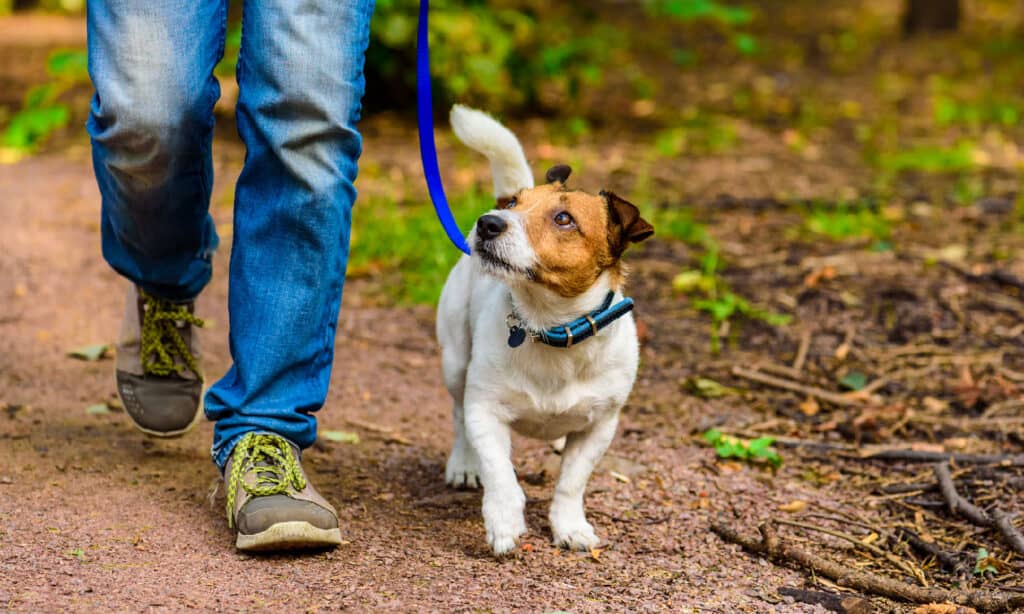
The most important thing to keep in mind is that this breed will grow bored easily with repetitious activities.
©iStock.com/alexei_tm
In order to discipline its active and roaming mind, the Russell Terrier will benefit from the direction of a strong leader and a regular training regime. Owners should appear firm and in control without being aggressive or mean. The most important thing to keep in mind is that this breed will grow bored easily with repetitious activities, so you should limit the sessions to no more than 15 or 20 minutes at a time; also try to get creative and change up your routine whenever you can. Fortunately, the Russell Terrier is quite intelligent and able to figure out human commands quickly. Obedience training needs to be combined with socialization opportunities as early as possible so it becomes more comfortable around unfamiliar people, animals, and situations.
Exercise

This is an agile little dog that can perform very well with all sorts of tricks and challenges.
©iStock.com/alexei_tm
This is a high-energy breed that probably needs around 30 to 60 minutes of exercise a day, preferably in the form of walks, runs, fetching, and playtime. This breed does have a tendency to wander around and chase after animals, so it is best to keep it on a leash or let it loose in a fenced yard so that it cannot jump over or dig under. The Russell Terrier is also an agile little dog that can perform very well with all sorts of tricks and challenges.
Puppies
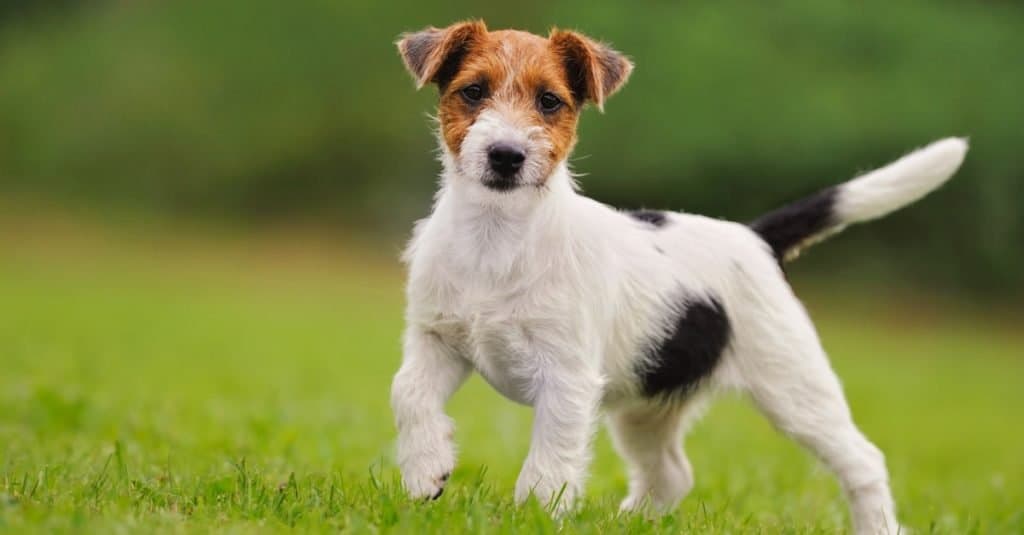
You should always adopt your puppies from a well-regarded rescue or adoption group.
©anetapics/Shutterstock.com
These puppies can be a little undisciplined and mischievous but also eager to please their human owner. They just need a very firm training and socialization system to become a well-adjusted full-grown adult. For best results, you should always buy puppies from high-quality breeders who screen for health problems. If that proves difficult, then the next best option is a well-regarded rescue or adoption group.
Russell Terriers And Children
These dogs are excellent family dogs. Its friendly, devoted, and loyal personality makes it a great companion for all dog lovers. This breed should get along with even younger children, although you may want to supervise all interactions between them.
Dogs Similar To Russell Terriers
The Russell Terrier bears many strong similarities to other breeds of terrier. Here are just a few of them:
- Irish Terrier – Sporting a fierce red coat and long, coarse hair, which gives it the appearance of a massive beard and eyebrows, the Irish Terrier is a determined, fearless, and energetic companion that will endear itself to its owner.
- Australian Terrier – Having been bred from several generations of British terriers, this little dog has a very big personality full of confidence, courage, and spirit. The rough coat, which has unique furnishings around the neck and chest, comes in blue and tan, red, and sandy colorations.
- Kerry Blue Terrier – Named after the Irish county in which it was first bred, this dog looks a lot like a Scottish Terrier, except its coat comes in various shades of blue, from light gray to a deeper shade. Its alert, inquisitive, and intelligent nature makes it a good watchdog and a companion for the entire family.
Famous Russell Terriers
Both the Russell Terrier and Jack Russell Terrier are fairly popular throughout Europe and the United States. Uggie (actually a Jack Russell Terrier) was a star in the Oscar-winning 2011 French film “The Artist.” Another Jack Russell named Bothy became the only dog to venture to the North and South Poles in 1982 and Moose was the dog from “Frasier”, who went by the name Eddie on the popular TV show.
Popular Names For Russell Terrier
Here are several suggestions for good Russell Terrier names:
- Bella
- Daisy
- Lucy
- Lily
- Buddy
- Milo
- Max
- Jack
- Charlie
- Penny
Russell Terrier FAQs (Frequently Asked Questions)
What is a Russell Terrier?
A Russell Terrier is a small breed of working terrier that had its origins in the fox hunting circles of the 19th century. This breed has straight fur of varying lengths with white, tan, and/or black markings. The coat is not hypoallergenic.
Is a Russell Terrier the same as a Jack Russell Terrier?
Both breeds of dogs are very similar – so much so that some organizations do not recognize them as different. But when they are recognized, the Russell Terrier tends to be the smaller breed of the two.
What is the lifespan of a Russell Terrier?
The average lifespan of a Russell Terrier is some 12 to 14 years.
How big do Russell Terriers get?
A full-grown Russell Terrier rarely exceeds 15 pounds.
What is the temperament of a Russell Terrier?
The Russell Terrier has an alert, friendly, and curious temperament with a strong-minded and independent streak that some owners may find endearing though other owners may find somewhat stubborn to deal with.
Thank you for reading! Have some feedback for us? Contact the AZ Animals editorial team.
Sources
- American Kennel Club / Accessed March 26, 2021
- Doggie Designer / Accessed March 26, 2021






